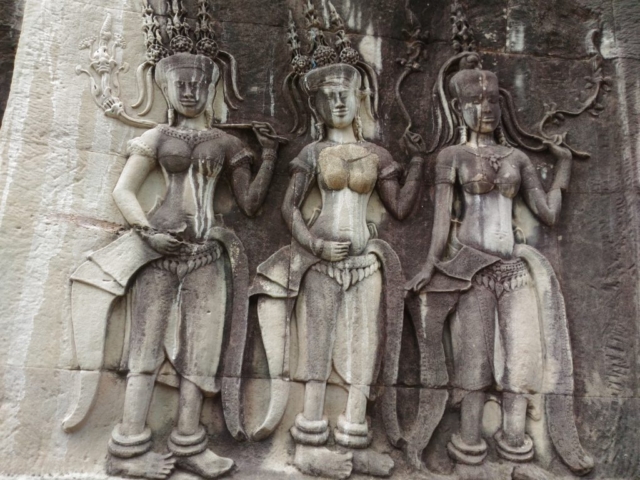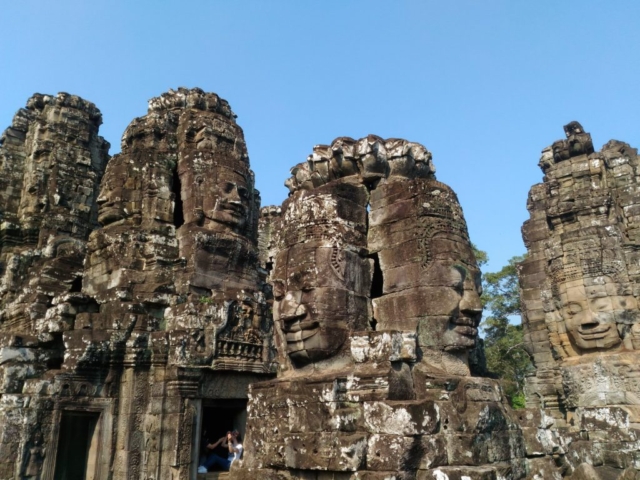History
The L’aang Spean cave in Battambang province is considered to be the oldest archaeological discovery in Cambodia. The key event in Cambodian prehistory was the slow penetration of the first rice growers from the North, which began at the end of the third millennium B.C.
During the 3rd, 4th and 5th centuries, the Indian states of Funan and his successor Chenla joined together in today’s Cambodia and southwest Vietnam. For more than 2,000 years, Cambodia has become another civilization in Southeast Asia. The formation of the Khmer Empire took place from the 9th to the 15th century. Around the 13th century, monks from Sri Lanka presented Theravada Buddhism. This religion spread and eventually pushed Hinduism and
The Khmer Empire was the largest empire of Southeast Asia during the 12th century. The Roman center of power was Angkor and Angkor Wat (the most well-known and best preserved religious temple still serving as a reminder of Cambodia’s history). After a long series of wars with neighboring kingdoms, Angkor was thrown out of the kingdom of Ayutthaya and abandoned in 1432 due to ecological failure and infrastructure failure. This decision led to periods of economic, social and cultural stagnation when the internal affairs of the kingdom were still under the control of their neighbors.
The first mention of Cambodia in European documents was in 1511. Portuguese travelers described the city as the site of the prosperity of wealth and foreign trade. In the 19th century, a renewed struggle between Siam and Vietnam for the control of Cambodia resulted in a time when Vietnamese officials were trying to force Khmer to accept Vietnamese customs. The war ended with an agreement to place the country under common domination. This later led to the signing of a contract for the French protection of Cambodia by King Norodom Prohmborirak.
French colonization
In 1863 King Norodom sought protection from the French government in Thailand. In 1867, the Thai King signed a treaty with France and surrendered dominion over Cambodia in exchange for control of the provinces of Battambang and Siem Reap, which officially became part of Thailand.
Cambodia continued as a protectorate of France from 1867 to 1953, which was administered as part of a colony of French Indochina. The next king was Norodom Sihanouk and the French thought that he will be easily manipulated. Instead, Cambodia gained independence in 1953 under his government.
Khmer Republic (1970-75)
The coup and the new regime immediately demanded that the Vietnamese Communists leave Cambodia. This regulation resulted in Vietnam’s armed attacks on the new government. Once gained control over Cambodian territory, the Vietnamese Communists established a new political infrastructure that ultimately dominated the Cambodian Communists, referred to as The Khmer Rouge.
The Khmer Rouge (1975-1978)
The Khmer Rouge took power in 1975. Under the leadership of Pol Pot, the official name of the country was changed to Democratic Kampuchea. The new regime immediately evacuated the cities and sent the entire population to forced marches and rural projects where they attempted to restore the country’s agriculture to a model of the 11th century. They excluded Western medicine, and to destroy temples, libraries and whatever consider Western.
Estimates of how many people were killed under the Khmer Rouge regime range from about one to three million (about a quarter of the population). During this time, the term “Killing Fields” came into being and Tuol Sleng’s prison was famous for its history of mass murders. Hundreds of thousands of people fled across the border to neighboring Thailand. Most of the victims were experts (eg doctors, lawyers, teachers, but also people with glasses, etc.) Religious institutions were also persecuted and 95% of Buddhist temples were destroyed.
Restoration of the monarchy
In 1993, Norodom Sihanouk was again head of state as the king of Cambodia, but all power was in the hands of the government.
Cambodia – officially the Kingdom of Cambodia
The kingdom is an optional constitutional monarchy with a monarch, currently Norodom Sihamoni, elected Council of the Royal Throne as head of state. The head of government is Prime Minister, currently Hun Sen, the longest-serving leader in Southeast Asia, who has been in power since 1985.
Policy
The Prime Minister is the head of government, while the King of Cambodia is head of state. The Prime Minister is appointed by the King with the consent of the National Assembly. The Prime Minister and appointed Ministers exercise executive power. The government in Cambodia is listed as one of the cruelest in the world.
Legislative power is shared by Cambodia’s executive and a bicameral parliament, which consists of the National Assembly and the Senate. The Members of the 123rd Assembly are elected by proportional representation. The Senate has 61 mandates, two of which are appointed by the King and two more by the National Assembly, the rest being elected by municipal councilors from 24 provinces of Cambodia.
The Cambodian People’s Party (CPP) is the only dominant party in Cambodia. Since 2018, the CPP in Parliament has all but four seats, including all 125 seats in the National Assembly and 58 out of 62 seats in the Senate.
Corruption
The level of corruption in Cambodia exceeds most of the world’s countries. Despite the adoption of the Anti-Corruption Act in 2010, corruption prevails across the country. Corruption affects the judiciary, the police, and other state institutions.
Religion
The official religion is THE THERAVADA BUDDHISM (95 percent in the population).
People
Fifty percent of the Cambodian population is under the age of 22. The vast majority of the population of Cambodia has the ethnic origin of Khmer (more than 95%). The population is largely homogeneous. Among its minority groups are Chams (1.2%), Vietnamese (0.1%) and Chinese (0.1%).
Culture
There are several factors contributing to Cambodian culture, including the Theravada Buddhism, Hinduism, French colonialism, Angkor culture, and modern globalization. It has distinctive style dances and architecture (Angkor Wat is the best-preserved example of architecture)
Bon Om Tuuk – The rowing competition and the most visited Cambodian national festival.
Festival of the Dead – Cambodians visit pagodas all over the country and offer food and prayers to the spirits of their dead relatives. At the same time, relatives who died during the Red Khmer regime are also reminded.















